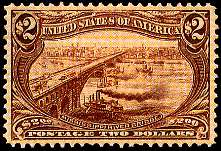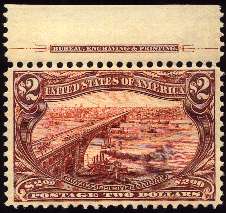
|
<<<< |

|
>>>> |

|

TRAINS ON U. S. STAMPS
and POSTAL STATIONERY
page 2

Embossed postcard with train image - Limited Express |
LAWRENCE & MARTINPrivate Die Proprietary Tax Stamp - 1880
This stamp is listed with the Medicine series (all begin "RS"), but the stamp itself says nothing about the product it accompanied, nor do any of the references at my disposal. The size and shape - about 3/4" x 7-1/2" - suggest that it went on a bottle, jar or tin - it is certainly a magnificent example of the engraver's art. Note the words "FOUR CENTS" repeated throughout the background of the central area. The ATA Handbook describes it thus: 4¢ black - Steam locomotive, railway workers and passengers at station The engraving is detailed enough that you can see the locomotive quite clearly on the high-res scan, and I feel quite comfortable saying it is a 4-4-0 "American". This is the only "Medicine" stamp that shows a train. Here's some very entertaining information about the company that produced the stamp (courtesy of Norm Wright, ATA Handbook editor):
So apparently my guess that this went on a bottle was correct, though what a train had to do with the product is a mystery. A little more about the company HERE |
|||
2¢MISSISSIPPI RIVER BRIDGE (Eads Bridge)
The scan above shows the auction catalog photograph of one of the finest copies extant of this stamp, lot 499 from the Siegel Auction Galleries sale of the Robert Zoellner Collection, on October 8, 1998 - it realized $11,000 plus 10%" buyer's premium. Even the most common member of the set, the 2¢ stamp, of which 160 million were issued, catalogs $27.50 for a nice mint copy, while only 56,200 of this $2 stamp, the high value of the set, were issued, making its high price more understandable. Or perhaps you would prefer the one below - it was lot 1780 in Seigel's Sale 836, April 11-13, 2001. They described it as "EXTREMELY FINE GEM", and expected it to sell for several multiples of its Scott catalog value, $4,250. It realized $8,000, plus commission, and the high-res version certainly does show even the tiniest details of this beautiful stamp (click on the image to view enlargement).
The rail connection here is dual. The bridge when built carried trains on its lower level, and streetcars on the upper level. Many railroad-stamp collectors include train bridges in their collections, but I choose not to, unless there is a train visible on the bridge. That would be impossible in this case, as the lower level of the bridge is hidden from view at this angle. (The bridge is still in use, but no longer carries rail traffic.) But the stamp is listed in the ATA Handbook, and the streetcars and their tracks are visible, so I decided to include it. The original intent of the USPOD was to issue this stamp as a bicolor issue, with the vignettes in black, and the frames in the colors used for the version as eventually printed, but the Spanish-American War dictated economies (the BEP was busy printing revenue stamps to help pay the costs), so single color printing was used. The critics hated the stamps, calling them unnecessary, and their designs ridiculously ornate, the quality of their printing poor. Nonetheless, they sold well, and helped serve their purpose, to advertise the exposition in Omaha in the summer of 1898.
Other than on a package, there is probably no way one could have used this stamp legitimately as postage, so the only known covers are philatelic. Even so, they are scarce, and valuable. The cover above sold at a recent Siegel auction for $6,500. No FDC's of this stamp are known. Completed in 1874, the Eads Bridge , which spans the Mississippi River at St. Louis, was one of the wonders of the world in its time, so revolutionary that the processes needed to produce the steel rods for its construction did not even exist when it was proposed, and its opponents said it could not be built. I saw a fascinating biography of James Eads on television recently. He was an amazing man, a genius who achieved engineering miracles and became a world-renowned celebrity for accomplishments such as this bridge, a marvel for its time. He was also responsible for the design and construction of ironclad warships during the War Between the States, and a channel at the mouth of the Mississippi River that for the first time made the transition from the River to the Gulf of Mexico navigable year-round. He seemed to specialize in projects that everyone said could not be done. At his death he was promoting the most grandiose scheme of his career, a huge railroad to transport ships above-ground across the Isthmus of Tehuantepec, in Mexico! Here's a link to a reproduction of a wonderful contemporary magazine article about the proposal, including drawings - it almost looks like it would work! In 1993 the Bureau of Engraving and Printing issued a souvenir card with another view of the Eads Bridge at the time of its construction. In this case there are neither streetcars on the upper deck, nor trains on the lower deck, but there is a train on land at the left, and the view of the bridge conveys its stucture better. ( Another excellent Eads site.) The Trans-Mississippi stamps were reissued in 1998 as a souvenir sheet. |
||||
US TRAINS
|
Send feedback to the webmaster: CLICK HERE
Revised -- 12/19/2004





